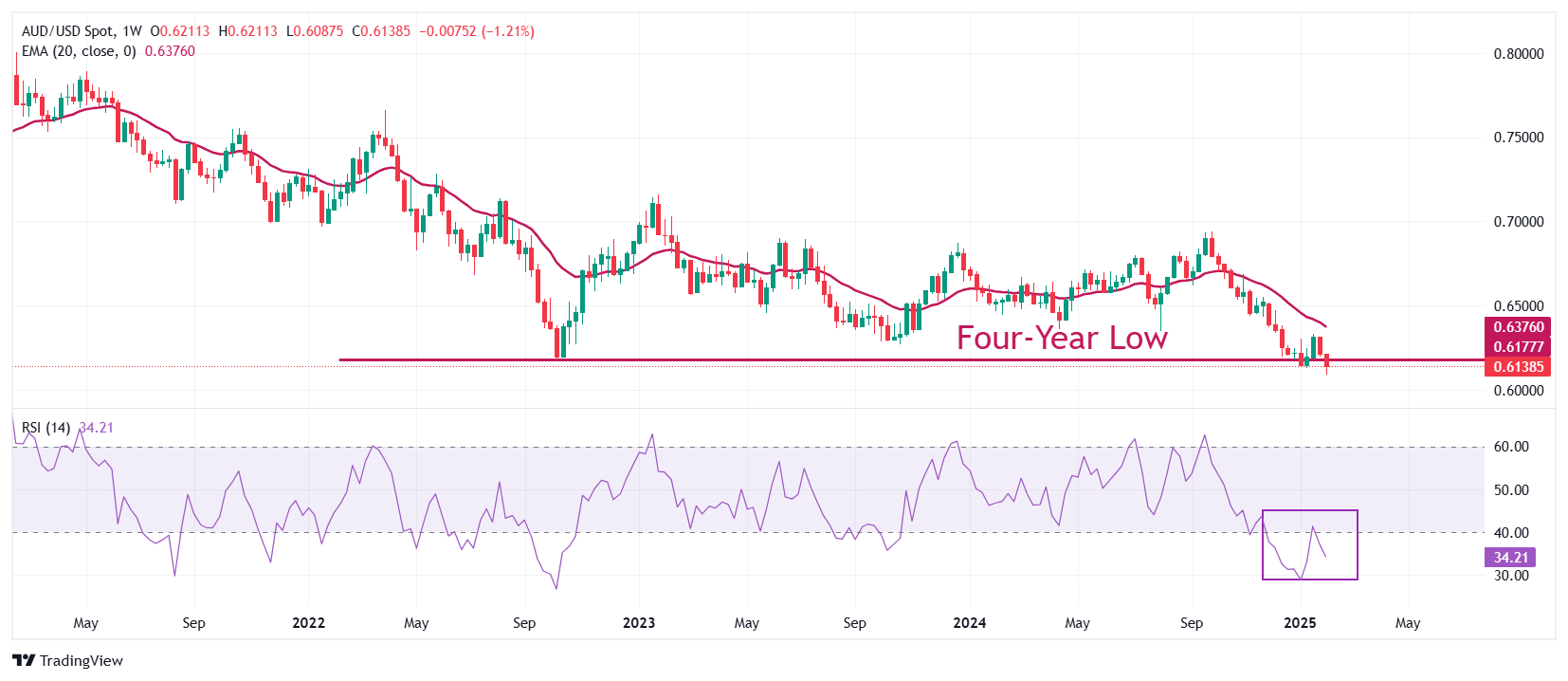AUD/USD Price Forecast: Posts fresh four-year low near 0.6100
- AUD/USD refreshes four-year low near 0.6100 as US President Trump imposes 10% tariffs on China.
- The RBA is widely anticipated to start reducing interest rates from the policy meeting this month.
- The US Dollar strengthens as US Trump starts global trade war.
The AUD/USD pair recovers slightly after plummeting to a fresh four-year low near 0.6100 but is still more than 1.10% down in Monday’s European session. The Aussie pair faces a sharp sell-off as Antipodeans pay the cost of being leading trading partners of China.
Over the weekend, United States (US) President Donald Trump imposed 10% tariffs on China and 25% on Canada and Mexico. This led to a sharp decline in the appeal of the Australian Dollar (AUD), which is a proxy for China’s economic outlook.
Apart from US tariffs on China, the Australian Dollar (AUD) has also weakened on the domestic front amid growing expectations that the Reserve Bank of Australia (RBA) will pivot to policy normalization from the policy meeting on February 18.
Meanwhile, the US Dollar (USD) has strengthened as Trump’s tariffs has improved its safe-haven appeal. The US Dollar Index (DXY), which gauges the Greenback’s value against six major currencies, climbs above 109.50.
In Monday’s session, investors will focus on the US ISM Manufacturing PMI for January, which will be published at 15:00 GMT.
AUD/USD posts a fresh four-year low around 0.6100. The 20-week Exponential Moving Average (EMA) near 0.6375 slopes downwards, suggesting that the overall trend is bearish. The 14-week Relative Strength Index (RSI) oscillates inside the 20.00-40.00 range, indicating a strong bearish momentum.
More downside would appear if the pair breaks below the immediate support of 0.6100, which would let it towards the psychological support of 0.6000 and 26 March 2020 low of 0.5870.
On the flip side, a sustenance move above the January 13 high of 0.6330 will open doors to the round-level resistance of 0.6400 and the December 5 high of 0.6456
AUD/USD weekly chart

US-China Trade War FAQs
Generally speaking, a trade war is an economic conflict between two or more countries due to extreme protectionism on one end. It implies the creation of trade barriers, such as tariffs, which result in counter-barriers, escalating import costs, and hence the cost of living.
An economic conflict between the United States (US) and China began early in 2018, when President Donald Trump set trade barriers on China, claiming unfair commercial practices and intellectual property theft from the Asian giant. China took retaliatory action, imposing tariffs on multiple US goods, such as automobiles and soybeans. Tensions escalated until the two countries signed the US-China Phase One trade deal in January 2020. The agreement required structural reforms and other changes to China’s economic and trade regime and pretended to restore stability and trust between the two nations. However, the Coronavirus pandemic took the focus out of the conflict. Yet, it is worth mentioning that President Joe Biden, who took office after Trump, kept tariffs in place and even added some additional levies.
The return of Donald Trump to the White House as the 47th US President has sparked a fresh wave of tensions between the two countries. During the 2024 election campaign, Trump pledged to impose 60% tariffs on China once he returned to office, which he did on January 20, 2025. With Trump back, the US-China trade war is meant to resume where it was left, with tit-for-tat policies affecting the global economic landscape amid disruptions in global supply chains, resulting in a reduction in spending, particularly investment, and directly feeding into the Consumer Price Index inflation.

